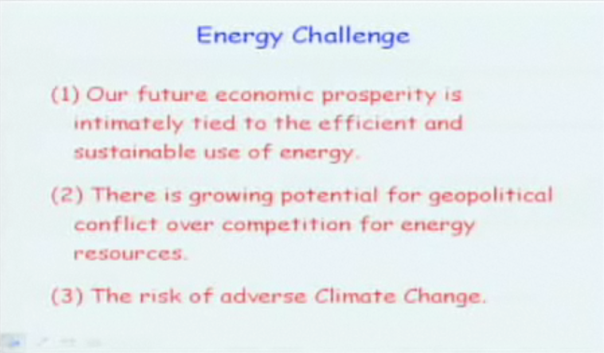Steven Chu’s inspiring Compton Lecture at MIT on May 12, 2009 made it viscerally clear to me that this will be an extraordinary time for clean energy and our country. President Susan Hockfield introduced Chu as the “academic black sheep” in his family having received only one PhD (from Berkeley) while most family members had two of them. He is the first working scientist to become Energy Secretary and the only Nobel Laureate to be in a presidential cabinet.
This is change you can believe in.

I took notes during his lecture and have summarized a few major themes, but I encourage you to spend one hour listening to Steven Chu’s Compton Lecture “The Energy Problem and the Interplay between Basic and Applied Research”.
Chu caught our attention by saying that scientists over the last decade have underestimated the damage from climate change. These predictions for the melting arctic ice cap, rising sea levels and dying pine forest in British Columbia were too conservative. Scientists accurately predicted that 40% of our pine forest in British Columbia would be gone, but the arctic ice cap and sea levels are at or worse than their forecasted worst case tolerance.
If this did not leave one feeling unsettled Chu added that we absolutely must prevent the carbon in long term frozen storage in the Canadian and Russian tundra from thawing. He framed the problem by saying that “unacceptable” tundra thawing would create a repetitive thaw, CO2 release, and warming cycle. This potentially released CO2 from the tundra is comparable to the amount of CO2 released by all human activity into the atmosphere.
Science and technology have solved our problems before and Chu provided energy inefficient and efficient refrigerators as an example. Over the last 30-40 years the average refrigerator grew in size from 18 to 22 cubic feet, but now uses 1/4 the energy at 1/2 the cost compared to it’s 18 cubic foot ancestor.
The largest slice of the energy consumption pie chart is residential and commercial buildings at 40%. Chu points out that plane design changes at Boeing recalculate their impact on energy measurables in real time. Construction cost overruns for buildings result in the stripping out of energy efficient measures and commissioning (tuning energy systems). He estimates that energy efficient design and real time usage analysis could reduce energy consumption by as much as 80% for residential and commercial buildings and consequently reduce overall energy consumption by 32%.
Chu was inspired working at Bell Laboratories and is implementing their innovation model. Bell Laboratories Managers were the best practical scientists in their field and had intimate knowledge of the people in their departments. They connected the right people to one another and deployed resources quickly. They hired young scientists and researchers and fostered an idea-rich culture without secrecy. There were so many good ideas that one was happy to see someone else “take” one and run with it.
The U.S. spends $26 billion per year on energy research and development (R&D) and the stimulus adds $37 billion in total to that over two years. President Obama has called for a doubling in basic science expenditures. Chu explains that a corporation spends about 10% of it’s revenue on R&D. The U.S. has a one trillion dollar annual energy expenditure which by comparison should fund a $100 billion investment annually in R&D.
In closing, Chu reminded us of the Apollo 8 photograph that the crew took of the earth when they came around the back side of the moon. They commented “We traveled to explore the moon, but we discovered the earth.”
Chu said “It’s our home. Let’s take care of it.”
… thunderous applause …
